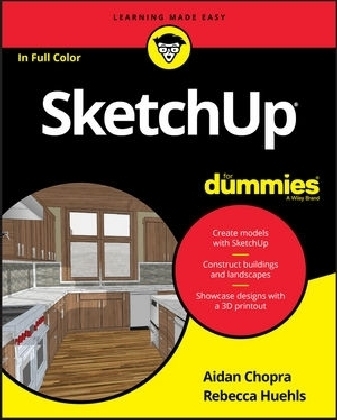
SketchUp For Dummies
John Wiley & Sons Inc (Verlag)
978-1-119-33615-0 (ISBN)
- Titel erscheint in neuer Auflage
- Artikel merken
Design almost anything in 3D with SketchUp Whether you've dabbled in drawing in 3D or are interested in learning the basics of design, SketchUp For Dummies makes it fast and easy to learn the ropes of a powerful, user-friendly tool to bring your design ideas to life. From creating a basic 3D model to showing off your work via 3D print or animation, this all-access guide pulls back the curtain on using SketchUp to do anything from redesigning your house to mocking up the next great invention. With an emphasis on usability, SketchUp has found very wide success as a tool even non-designers can use to make basic drawings. And now, thanks to the insight and expert tips from former SketchUp product director Aidan Chopra and co-author Rebecca Huehls, this easy-to-follow guide makes it more accessible than ever! * Create buildings and components * Alter the appearance of your model * Tour your designs via SketchUp * Get quick tips on troubleshooting If you're a designer with sketchy computer modeling skills, SketchUp For Dummies is the trusted reference you'll turn to again and again.
Aidan Chopra is a former SketchUp evangelist and author of previous editions of SketchUp For Dummies. Rebecca Huehls creates content for the help system on current versions of SketchUp.
Introduction 1
About This Book 1
Foolish Assumptions 2
Icons Used in This Book 2
Beyond the Book 3
Where to Go from Here 3
Part 1: Getting Started with SketchUp 5
Chapter 1: Meeting SketchUp 7
Things You Ought to Know Right Away 8
Comparing SketchUp to Other 3D Modeling Programs 8
Jumping right in 8
Understanding the difference between paper and clay 9
What You Should (and Shouldn’t) Expect SketchUp to Do 10
Taking the Ten-Minute SketchUp Tour 12
Customizing the toolbar 15
Checking out some special tools 15
Chapter 2: Getting a Running Start 17
Setting Up Your Workspace 17
Making a Quick Model 19
Slapping On Some Paint 25
Giving Your Model Some Style 28
Switching On the Sun 30
Sharing Your Masterpiece 32
Chapter 3: Establishing the Modeling Mindset 33
All about Edges and Faces 34
Living on the edge 34
Facing the facts about faces 35
Understanding the relationship between edges and faces 37
Drawing in 3D on a 2D Screen 39
Giving instructions with the drawing axes 40
Keeping an eye out for inferences 41
Using inferences to help you model 43
Warming Up Your SketchUp Muscles 45
Getting the best view of what you’re doing 45
Drawing and erasing edges with ease 47
Injecting accuracy into your model 48
Selecting what you mean to select 52
Moving and copying like a champ 55
Rotating the right way 60
Making and using guides 62
Painting your faces with color and texture 65
Part 2: Modeling in SketchUp 69
Chapter 4: Building Buildings 71
Drawing Floors and Walls 72
Starting out in 2D 73
Coming up with a simple plan 77
Going from 2D to 3D 84
Adding floors to your building 89
Inserting doors and windows 97
Staring Down Stairs 101
The Subdivided Rectangles method 102
The Copied Profile method 104
Raising the Roof 106
Building flat roofs with parapets 107
Creating eaves for buildings with pitched roofs 109
Constructing gabled roofs 110
Making hip roofs 112
Sticking your roof together with Intersect Faces 114
Chapter 5: Falling in Love with Components 119
Grouping Things Together 120
Working with Components 121
What makes components so great? 122
Exploring the Components panel 126
Creating your own components 131
Editing, exploding, and locking component instances 134
Discovering Dynamic Components 136
Taking Advantage of Components to Build Better Models 142
Modeling symmetrically: Good news for lazy people 143
Modeling with repeated elements 149
Chapter 6: Going Beyond Buildings 153
Extruding with Purpose: Follow Me 154
Using Follow Me 154
Making lathed forms like spheres and bottles 156
Creating extruded shapes like gutters and handrails 157
Subtracting from a model with Follow Me 163
Modeling with the Scale Tool 167
Getting the hang of Scale 167
Scaling profiles to make organic forms 171
Making and Modifying Terrain 177
Creating a new terrain model 177
Editing an existing terrain model 184
Building a Solid Tools Foundation 193
Understanding solids 193
Checking out the Solid Tools 195
Putting the Solid Tools to work 198
Chapter 7: Keeping Your Model Organized 203
Taking Stock of Your Tools 203
Seeing the Big Picture: The Outliner 205
Taking a good look at the Outliner 205
Making good use of the Outliner 206
Discovering the Ins and Outs of Layers 207
What layers are — and what they’re not 207
Navigating the Layers panel 208
Moving entities to a different layer 209
Staying out of trouble 210
Putting It All Together 211
Chapter 8: Modeling with Photos and Other Resources 215
Painting Faces with Photos 216
Adding photos to flat faces 216
Editing your textures 220
Adding photo textures to curved surfaces 226
Modeling Directly from a Photo: Introducing Photo-Matching 230
Choosing a Match Photo-friendly image 231
Modeling by photo-matching 232
Making your matched photo reappear (or disappear) 238
Modeling on Top of Photo Textures 239
Making a texture projected 239
Modeling with projected textures: A basic workflow 240
Adding Geographic Data 241
Geo-locating your model 242
Viewing your model in Google Earth 244
Working with Imported CAD files 245
Importing a CAD file into SketchUp Pro 245
Cleaning up imported CAD data 247
Modeling on top of imported CAD data 251
Chapter 9: 3D Printing with SketchUp Models 259
Building Up a View of 3D Printing 260
Building a Model in Layers 260
Supporting layers from below 260
Designing to avoid support material 261
Bridging 262
Preparing a SketchUp Model for 3D Printing 263
Peeking inside a model 263
Knowing what makes a solid model 264
Using Solid Tools to combine groups 265
CleanUp3 and Solid Inspector2 266
Combining groups with Intersect Faces 267
Checking a model’s normals 269
Checking your model’s size 270
Breaking Your Model into Parts 272
Exporting Your SketchUp File 276
Knowing Your 3D Printers 277
Desktop 3D printers 277
Professional 3D printers 279
3D printing services 279
Using Your 3D Printer 280
Print early, print often 280
Inside your model 281
Going beyond Basic 3D Printing 282
Designing parts that connect 282
Testing your model’s moving parts 286
Designing Things That Move 286
Captive joints 287
Pins 287
Gears 288
Part 3: Viewing Your Model in Different Ways 291
Chapter 10: Working with Styles and Shadows 293
Styling Your Model’s Appearance 294
Choosing how and where to apply styles 294
Applying styles to your models 295
Editing your styles 297
Creating a new style 313
Saving and sharing styles you make 314
Working with Shadows 317
Discovering the shadow settings 317
Adding depth and realism 319
Creating accurate shadow studies 323
Chapter 11: Presenting Your Model inside SketchUp 329
Exploring Your Creation on Foot 330
These tools were made for walking 330
Stopping to look around 332
Setting your field of view 333
Taking the Scenic Route 334
Creating scenes 336
Moving from scene to scene 337
Modifying scenes after you make ’em 341
Mastering the Sectional Approach 347
Cutting plans and sections 348
Animating sections with scenes 356
Part 4: Sharing What You’ve Made 359
Chapter 12: Paper or Cloud? Printing and Uploading Your Work 361
Printing Your Work 362
Printing from a Windows computer 362
Printing from a Mac 367
Printing to a particular scale 371
Working with the 3D Warehouse 374
Why Warehouse? 375
Getting to the 3D Warehouse 376
Uploading a model 376
Managing models online 378
Chapter 13: Exporting Images, Animations, and CAD Files 381
Exporting 2D Images of Your Model 381
Introducing raster versus vector files 382
Exporting a raster image from SketchUp 382
Looking at SketchUp’s raster formats 387
Making sure you export enough pixels 389
Making Movies with Animation Export 394
Getting ready for prime time 394
Exporting a movie 395
Figuring out the Animation Export Options settings 397
Exporting a CAD File 399
Preparing your file 399
Exporting a 2D DWG file 400
Exporting a 3D DWG file 400
Chapter 14: Creating Presentations and Documents with LayOut 403
Building a LayOut Document 404
Customizing a document’s pages and layers 404
Adding and editing text 408
Inserting SketchUp model views 409
Adding photos and other graphics 416
Drawing with LayOut’s vector tools 417
Annotating with labels 419
Displaying dimensions 420
Creating tables 425
Creating Your Own Templates 426
Putting Together Your Own Scrapbooks 427
Getting Your Document Out the Door 428
Printing your work 429
Exporting a PDF or image files 429
Exporting a DWG or DXF file 430
Going full screen 431
Part 5: The Part of Tens 433
Chapter 15: Ten SketchUp Traps and Their Workarounds 435
SketchUp Won’t Create a Face Where You Want It To 435
Your Faces Are Two Different Colors 436
Edges on a Face Won’t Sink In 437
SketchUp Crashed, and You Lost Your Model 437
SketchUp Is Sooooo Slooooooooow 438
You Can’t Get a Good View of the Inside of Your Model 439
A Face Flashes When You Orbit 440
You Can’t Move Your Component the Way You Want 440
Bad Stuff Happens Every Time You Use the Eraser 440
All Your Edges and Faces Are on Different Layers 441
Chapter 16: More Than Ten Ways to Learn About SketchUp 443
Free Online Resources 443
The Ultimate SketchUp Reading List 445
Other Tools from the Makers of SketchUp 446
Index 449
| Erscheinungsdatum | 04.05.2017 |
|---|---|
| Verlagsort | New York |
| Sprache | englisch |
| Maße | 191 x 230 mm |
| Gewicht | 840 g |
| Themenwelt | Informatik ► Office Programme ► Outlook |
| ISBN-10 | 1-119-33615-5 / 1119336155 |
| ISBN-13 | 978-1-119-33615-0 / 9781119336150 |
| Zustand | Neuware |
| Haben Sie eine Frage zum Produkt? |
aus dem Bereich



